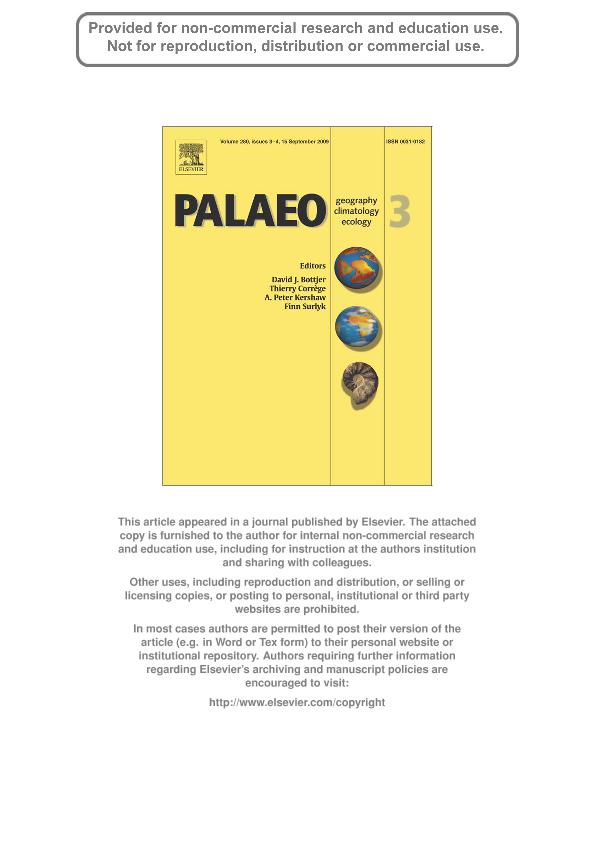Artículo
Comment on “The oldest South American Cricetidae (Rodentia) and Mustelidae (Carnivora): Late Miocene faunal turnover in central Argentina and the Great American Biotic Interchange” by D.H. Verzi and C.I. Montalvo [Palaeogeography, Palaeoclimatology, Palaeoecology 267 (2008) 284–291]
Fecha de publicación:
09/2009
Editorial:
Elsevier Science
Revista:
Palaeogeography, Palaeoclimatology, Palaeoecology
ISSN:
0031-0182
Idioma:
Inglés
Tipo de recurso:
Artículo publicado
Clasificación temática:
Resumen
In a recent paper (Verzi, D.H., Montalvo, C.I., 2008. The oldest South American Cricetidae (Rodentia) and Mustelidae (Carnivora): late Miocene faunal turnover in central Argentina and the Great American Biotic Interchange. Palaeogeography, Palaeoclimatology, Palaeoecology 267, 284–291) the potentially oldest South American Cricetidae (Rodentia) and Mustelidae (Carnivora) have been reported from a Late Miocene (Huayquerian) assemblage located in central Argentina (Caleufú site, La Pampa province). These findings expand the biochron of these important families in South America 3–4 Ma earlier than previous records. However, several observations prevent us from accepting the validity of these assumptions. In this paper we discuss the age of the Caleufú assemblage, and the assignment of the GHUNLPam 21722 to Mustelidae. The Caleufú assemblage contains a mixture of Pliocene and Late Miocene faunal elements, and has been assigned to the Huayquerian only due to the “stage of evolution” of some rodents. The lack of isotopic or paleomagnetic data coupled with the isolation of this locality and the absence of a local stratigraphic succession inhibit its correlation with other palaeontological comparable sites and a robust inference about its chronology. The “stage of evolution” of a taxon is not a biostratigraphic tool, thus we cannot rule out the possibility that the Caleufú assemblage has an Early Pliocene (Montehermosan) age. The GHUNLPam 21722, a poorly preserved specimen, shows several characters (e.g., 4 lower incisors, mental foramina below the incisors absent, third lower incisor smaller than the first and second ones) that do not match with Mustelidae (or Carnivora) but instead strongly resemble those observed in didelphimorphian marsupials. The discussed caveats regarding Caleufu assemblage chronology and taxonomy indicate that new and detailed studies are needed before the hypotheses advanced by Verzi and Montalvo can be accepted.
Archivos asociados
Licencia
Identificadores
Colecciones
Articulos(CCT-CENPAT)
Articulos de CTRO.CIENTIFICO TECNOL.CONICET - CENPAT
Articulos de CTRO.CIENTIFICO TECNOL.CONICET - CENPAT
Articulos(MACNBR)
Articulos de MUSEO ARG.DE CS.NAT "BERNARDINO RIVADAVIA"
Articulos de MUSEO ARG.DE CS.NAT "BERNARDINO RIVADAVIA"
Citación
Prevosti, Francisco Juan; Pardiñas, Ulises Francisco J.; Comment on “The oldest South American Cricetidae (Rodentia) and Mustelidae (Carnivora): Late Miocene faunal turnover in central Argentina and the Great American Biotic Interchange” by D.H. Verzi and C.I. Montalvo [Palaeogeography, Palaeoclimatology, Palaeoecology 267 (2008) 284–291]; Elsevier Science; Palaeogeography, Palaeoclimatology, Palaeoecology; 280; 3-4; 9-2009; 543-547
Compartir
Altmétricas




